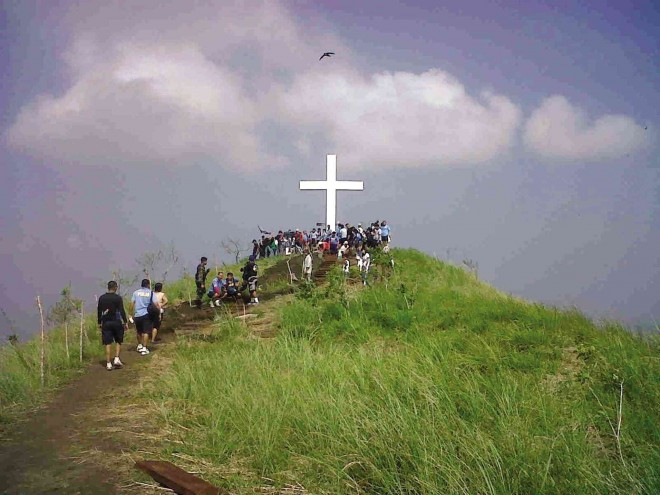
THE TAYAK Hill in Rizal town, Laguna province, served as a command post of Filipino-American troops in 1945. It is now being promoted as a local biking and hiking tourist destination. MARICAR P. CINCO/INQUIRER SOUTHERN LUZON
US defense officials are checking the claim of a poor farming town in Laguna province that it had been a key area for the Allied Forces during World War II in what a municipal official views as its big step toward official historical recognition.
Maj. Michael Charles Van Hoven, chief of the US Army and Marine Corps Programs, visited Tayak Hill in Rizal town on Dec. 10 and 11 to verify the claim, according to Vice Mayor Ferdinand Sumague.
The local official had earlier requested the US Department of Defense to validate Rizal’s claim that Tayak Hill once served as the guerrilla headquarters of the Allied Forces during the war.
Van Hoven, who was sent by the Joint US Military Assistance Group (Jusmag), and Col. Rocky Carter, chief of Jusmag-Philippines, went up the 560-meter plateau in Barangay Tala, took pictures and obtained the coordinates of Tayak Hill, Sumague said.
“(Van Hoven) was noncommittal, although he seemed optimistic and enthusiastic about it. He also discussed with us plans like holding the Balikatan (joint Philippine-US military) exercises or replicating an (military) airstrip (on Tayak Hill),” he said in a phone interview last week.
Should their claim be authenticated, Rizal, a fifth-class municipality (annual income: P15 million-P25 million), could finally find its place in history and own something it could be known for, Sumague said.
The town based its claim on a 1982 book “For Love of Freedom—Japanese Occupation,” a personal account by war veteran Juan Hernandez. On page 199 of the book, the author wrote that a taxi strip and airfield were built by guerrilla Col. Gertrudo San Pedro on Tayak Hill in February 1945.
“From here had been airlifted three American pilots rescued by San Pedro outfit when the airmen’s bomber soft-landed in Nanhaya, Pila, Laguna, after a bombing mission at the Manila area. They were Majors Charles Howe and Thompkins, and Sergeant Bretain of the 5th Attack Group, US Air Squadron. From here also had been airlifted Mrs. Virginia Llamas-Romulo, wife of Gen. Carlos P. Romulo, that she might join her husband in liberated Mindoro,” read the author’s caption.
The photo of the site shown on the book was credited to the ComAir 7th Fleet of the United States and the US National Archive.
In June, local mountaineers discovered vintage beer and cola bottles marked with the year “1953” in a ravine near Tayak Hill.
Another book, “Guerrilla Interview,” written by war veteran David Dwiggins, also mentions the place as the “dropping point” of ammunitions and war provisions for the guerrillas in Laguna.
Retired Lt. Gen. Ernesto Carolina, administrator of the Philippine Veterans Affairs Office, asked the US government in a Nov. 6 letter to US Ambassador to the Philippines Philip Goldberg to authenticate Rizal town’s claim as to “whether or not the municipal landmark known as Tayak Hill was used during World War II.”
“It may be noted that the municipality of Rizal is currently in the process of rediscovering their glorious and heroic past,” Carolina wrote. “It is hoped that through the verification and authentication of the said photograph, there shall be a better understanding of our nation’s history,” he said.